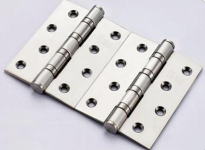Door hinges come in a variety of types, each designed for specific applications and with unique characteristics. Below is a classification of door hinges and the key differences between them:


1. Butt Hinges
Description: The most common type of hinge, typically used for doors.
Features: Consists of two plates (leaves) attached by a pin or rod.
Applications: Standard doors, cabinets, furniture.
Differences:
Often visible when the door is closed.
Available in various sizes for different door weights.
2. Ball-Bearing Hinges
Description: A variation of butt hinges, equipped with ball bearings.
Features: Designed to reduce friction.
Applications: Heavy doors, high-traffic areas.
Differences:
More durable and smoother operation compared to regular butt hinges.
Ideal for doors that need to open and close frequently.
3. Piano Hinges (Continuous Hinges)
Description: Long, continuous hinge that runs the entire length of a door or lid.
Features: Distributes weight evenly along the entire surface.
Applications: Cabinets, piano lids, industrial equipment.
Differences:
Offers more stability for large or heavy doors.
Suitable for applications requiring full-length support.
4. Concealed Hinges (European Hinges)
Description: Hidden from view when the door is closed.
Features: Mount inside the cabinet and door.
Applications: Kitchen cabinets, modern furniture.
Differences:
Adjustable for better alignment.
Sleeker appearance, with no visible hardware on the outside.
5. Flush Hinges
Description: Small, low-profile hinges that fit flush with the door and frame.
Features: Simple and lightweight.
Applications: Small cabinets, lightweight doors.
Differences:
Do not require a recess in the door or frame.
Less durable than butt hinges.
6. Spring Hinges
Description: Hinges with a spring mechanism to automatically close doors.
Features: Self-closing, adjustable tension.
Applications: Fire doors, doors in commercial buildings.
Differences:
Ideal for situations where doors need to remain closed for safety.
Can replace door closers in some applications.
7. Pivot Hinges
Description: Hinges that pivot from the top and bottom of the door rather than from the side.
Features: Allows the door to rotate smoothly.
Applications: Heavy doors, frameless doors, shower doors.
Differences:
Allows for a clean, modern look.
Supports more weight than standard hinges.
8. Offset Hinges
Description: Hinges that allow a door to swing further open than standard hinges.
Features: Extends the swing of the door.
Applications: Doors that need to provide more clearance (e.g., for wheelchairs).
Differences:
Can increase the opening width by up to two inches.
9. Barrel Hinges
Description: Concealed hinges typically used for cabinets and small boxes.
Features: Cylindrical in shape, hidden when the door is closed.
Applications: Small furniture, jewelry boxes, cabinets.
Differences:
Invisible from the outside.
Suitable for lightweight applications.
10. Flag Hinges
Description: Hinges with one fixed side and one removable pin.
Features: Allows for easy removal of the door without unscrewing the hinge.
Applications: Industrial settings, doors that need to be removed frequently.
Differences:
One part of the hinge can be lifted out, making door removal easy.
11. Overlay Hinges
Description: Used for cabinet doors that overlap the frame.
Features: Available in partial or full overlay styles.
Applications: Cabinets, particularly in kitchens.
Differences:
Designed to create a seamless, flush appearance when closed.
12. Strap Hinges
Description: Long decorative hinges with a strap extending across the door.
Features: Decorative and functional, often used on gates and barn doors.
Applications: Exterior doors, gates, barn doors.
Differences:
Offers an aesthetic appeal with a rustic or traditional look.
Strong and suitable for heavy doors.

Key Differences Between Hinges:
Functionality: Some hinges are self-closing (spring hinges), while others are designed for frequent removal (flag hinges).
Durability: Heavy-duty hinges like ball-bearing or pivot hinges are better suited for heavier doors, while flush and concealed hinges are for lightweight applications.
Appearance: Concealed hinges are hidden when the door is closed, offering a cleaner look, while decorative hinges like strap hinges add aesthetic appeal.
Application: The choice of hinge depends on the type of door (e.g., cabinet vs. exterior door), weight, and design preferences.
Each type of hinge serves a unique purpose, and the selection depends on factors like the door's weight, frequency of use, and aesthetic requirements.

